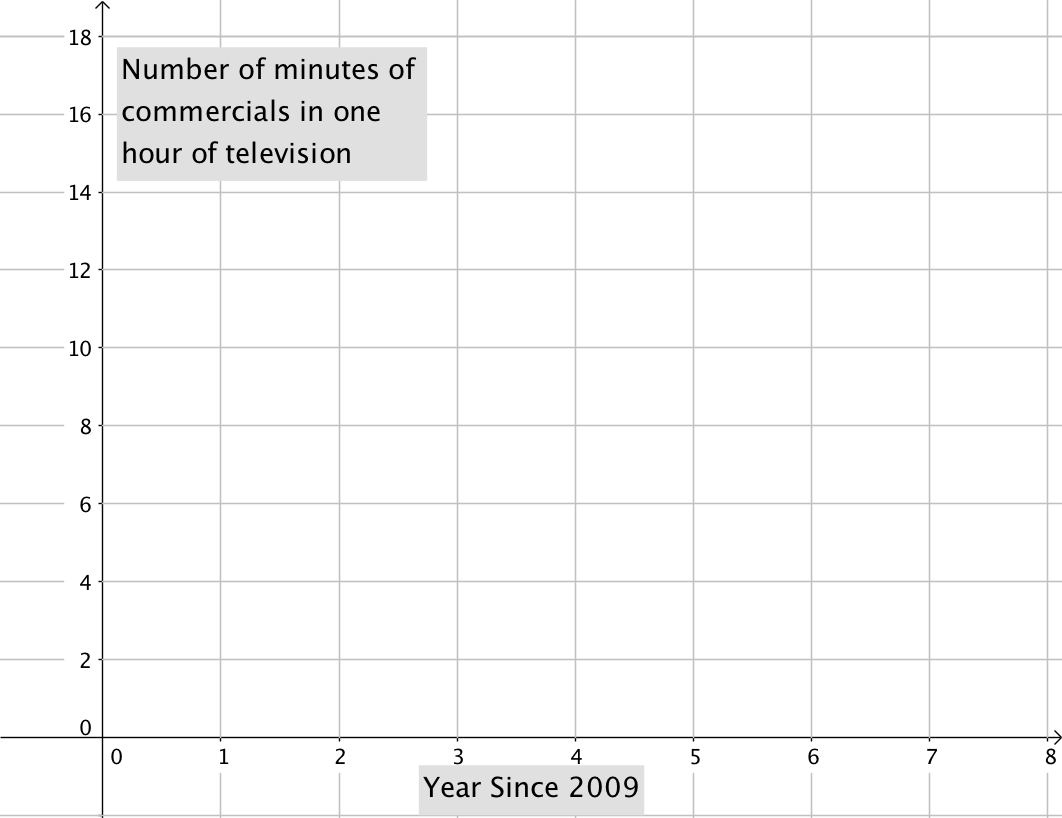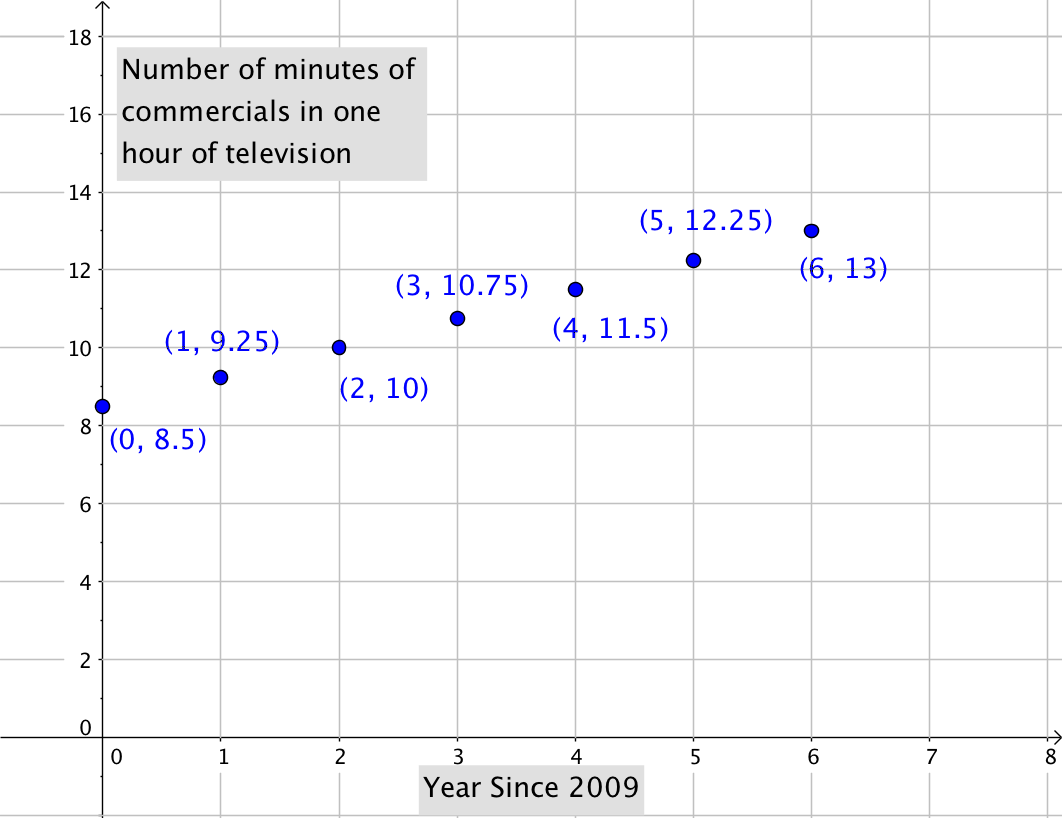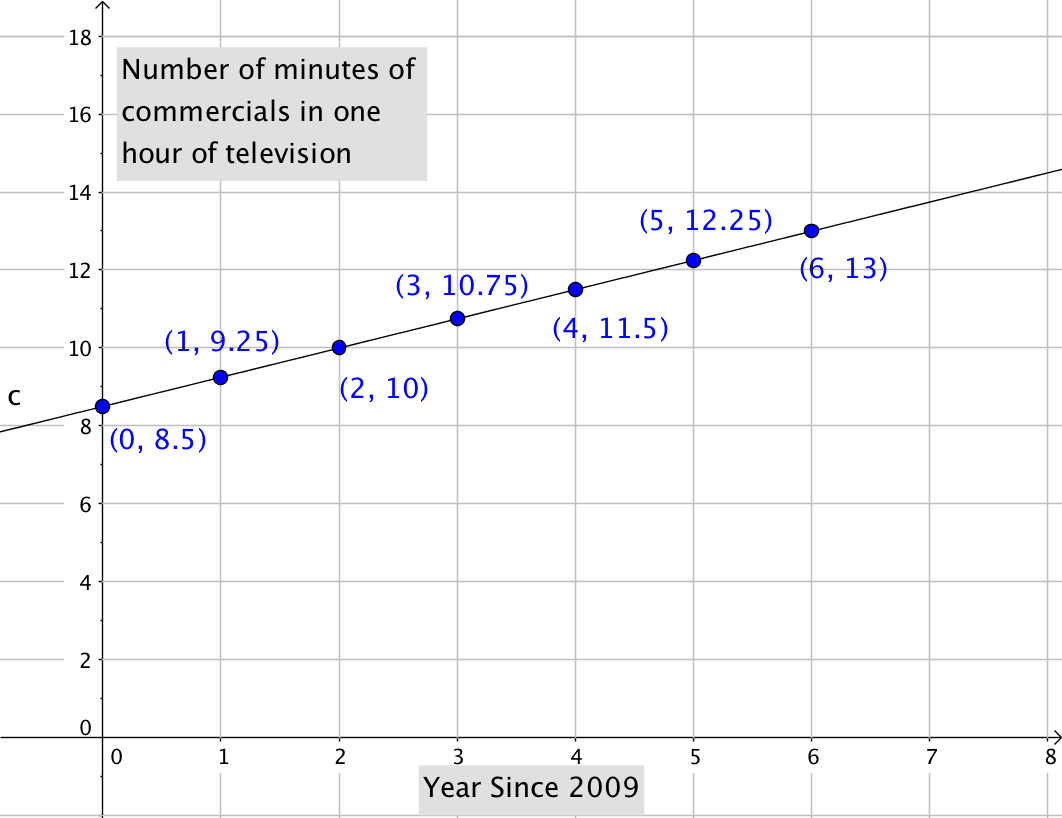
Suppose you are a semiprofessional blogger who writes about media (you’d really like to be a paid film critic, but no one has offered yet). Recently you posted a short blog piece complaining about the number of ads on TV these days, compared to when you were younger. You weren’t very scientific about it, and a couple of your readers disputed your claim and tried to start an argument with you.
Well, that got your attention. It made you wonder whether your perception of there being “way more” TV ads was accurate. You get online and do a little research, and you find a website that reports some interesting data on the number of minutes of TV commercials per hour since 2009, shown below:
| Years since 2009 | Minutes |
|---|---|
| 0 | 8.5 |
| 1 | 9.25 |
| 2 | 10 |
| 3 | 10.75 |
| 4 | 11.5 |
| 5 | 12.25 |
| 6 | 13 |
The data show that, yes, there are more commercials now than in 2009, but the table isn’t very exciting, and you doubt that your readers will care. You may not be a famous film critic yet, but you realize you can use what you’ve learned in math class to present this information as a graph—the perfect thing to post on your blog and convince your skeptical readers!
You get to work.
What information do you need to draw a graph of the line that represents the change in the number of minutes of commercials in one hour of TV since 2009?
The Cartesian Coordinate Plane
You remember that the coordinate plane gives your graph structure and meaning. A straight line on a page won’t tell your readers much. You draw the axes and label the horizontal one “Years Since 2009,” because that’s the first data point you have. You label the vertical axis from 1 to 18 because your minute data range from 8.5 to 13 minutes, and that will give you room on either side.

Then you plot the ordered pairs from your table of values on your coordinate plane, as below.

The points give you a guide for drawing your line, which you do, as below.

Things are looking pretty good, so you post your graph to your blog to show people how much more time they are being exposed to commercials in one hour of TV watching since 2009.
Then, it happens . . .
One of your readers asks if you can guess how many minutes of commercials will be in one hour of television ten years from now (assuming the current trend continues). After thinking about the question for a while, you realize you don’t have to guess! You have all the information you need to write the equation of the line you drew, and you recall that, with an equation, you can put in any value for the years since 2009.
Finding the Equation
You remember that knowing the slope and y-intercept of a line can help you write the equation of the line. You realize you have the y-intercept: [latex](0,8.5)[/latex]. Now, you just need the slope.
You check your math notes to find the definition of slope, and use two of your data points to calculate it:
[latex]\begin{array}{l} \text{Slope}=\frac{\text{rise}}{\text{run}}\\\\m=\frac{{{y}_{2}}-{{y}_{1}}}{{{x}_{2}}-{{x}_{1}}}\\\\m=\frac{{11.5}-{10.75}}{{4}-{3}}\\\\m=\frac{{0.75}}{{1}} = 0.75\end{array}[/latex]
Now you have the two pieces of information you need to write the equation of the line that represents how many minutes of commercials will be in one hour of TV in any year before or after 2009.
First choose your variables: x = the year and y = the number of minutes. You can substitute the values for m and b into the slope-intercept form of a line:
[latex]\begin{array}{l}{ y }= {m x} + {b}\\{ y }= {0.75 x} + {8.5}\end{array}[/latex]
Remembering that the whole point of this exercise was to answer your reader’s question, next you figure out what 10 years from now would be in relation to 0 representing 2009 on your graph. If 10 years from now is 2026, then it’s 17 years from 2009. The x value you need in order to answer the question is 17.
[latex]\begin{array}{l}{ y }= {0.75 (17)} + {8.5}\\\\{ y }= {12.75} + {8.5}\\\\{ y }= {21.25}\end{array}[/latex]
You have a new data point: [latex](17,21.25)[/latex]. This means that in 2026 there will be more than 20 minutes of commercials in one hour of TV. Yuck!